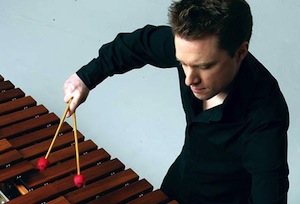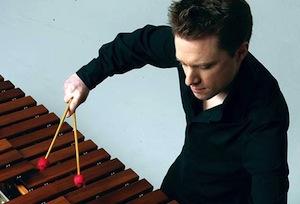
Over the past decade, Colin Currie's phenomenal artistry has spawned a host of major new works for percussion. Reich, Rautavaara, Carter, MacMillan, Andriessen, Aho, and Higdon — these are some of the many composers who have found inspiration in the 35-year-old Scotsman’s unique approach to his battery of instruments.
On Feb. 29, Currie leaps across the Atlantic to perform the U.S. premiere of a new concerto for percussion and orchestra by his homeland’s Sally Beamish. Given that Beamish, 55, composed her Stanford Lively Arts co-commission while holding in her mind the image of Currie as a dancer, it comes as no surprise that she has titled the work Dance Variations.
Reached by phone somewhere in the world — he’s on the road for more than half the year — Currie sounded anything but unbridled. Instead, he came across as an extraordinarily introspective percussionist whose art reflects an equal marriage of mind, body, and finely tuned emotional energy.
Featured Video
Colin Currie - Jennifer Higdon's Percussion Concerto
I think when I was very young, I did respond in a kind of innate way to rhythm and the music that surrounded me. At home, there was a mixture of classical music and jazz and some lighter pop music. I enjoyed all of them from an early age. But my main love at first was the drum kit, with its very immediate and exciting sound.
I was particularly influenced by Big Band drummer Buddy Rich. I actually saw him on his final European tour, shortly before he died of a heart attack, when I was about 10 years old. That was a very strong moment and made a big impression on me.
If you take the sound of the snare drum, which is one of the first instruments that you study as a percussionist, it’s such a crisp, clear, and loud sound. It’s a very exciting instrument to play. What you put into it gives you a thrill back.
I think I enjoyed the dexterity of the drum kit, with [my] four limbs combining to produce something that sounded groovy, fun, inventive — it’s all very appealing to a young musician.
When you initially got into percussion, did you think about playing the host of instruments you play now?
I was initially interested in pop music, jazz, things like that. When I started to become aware of orchestral music at the age of about 13, it became my new fascination. I desperately wanted to play the orchestral percussion instruments, such as the xylophone and the marimba, which was quite a new instrument at that point. Certainly, in the early ’90s, the standardized five-octave marimba we are used to hearing was still being developed.
Even as I wanted desperately to play orchestral music, I was developing a love of new music, as well. With that, the opportunity to play as a soloist came my way from quite an early age. It was basically there on the front burner from the beginning of my orchestral studies, and it was something that actually took over.
I would think that, as a percussionist in his 30s, you have a real opportunity to reach out to young people. Do you do much work with kids? How do they respond?
I try to do whatever I can, sometimes via orchestras, to reach out to disadvantaged and minority communities. I may perhaps share a performance with them, maybe do hands-on, and show something about the music I play and the way that people can team up and play grooves together.
I think percussion is the ideal force for music education — it’s something that people can get hands-on with very easily. If you go around with 20 French horns and hand them out to young people, they can’t do anything with that. But if you hand them the conga drum, everyone can get jamming together immediately.
The 11 a.m. matinee on March 1 at Stanford is when I’ll perform for maybe several hundred young students. It’s kind of a “percussion discovery” concert in which I’ll present many instruments, maybe perform a few pieces, and have lots of audience participation. There will be dozens of children joining me onstage.
Please tell us about the new Beamish concerto and the other works you’ll perform.
Sally Beamish, a leading British composer, also lives in Scotland where I’m from. I’ve known her for many years.
I think percussion is the ideal force for music education — it’s something that people can get hands-on with very easily.
We talked about a piece for a long time, especially about the musical ideas that might work. What we settled on is a set of variations. I’d been interested in having a piece written for me that would have dance variations — that is to say, perhaps dance forms from the Baroque era on to more contemporary things like swing. This piece has a variety of dance structures, themes, and ideas expressed in variations for percussion and chamber orchestra.
It’s mostly very delicate and quite light, very playful music. There are some moments when things get a little testy, shall we say. But by and large, it’s a very exuberant and dancelike piece of music. It’s a major addition to the percussion repertoire.
Have you performed it before?
It’s been commissioned by four organizations: Swedish Chamber Orchestra, Scottish Chamber Orchestra, Stanford Lively Arts, and the Bergen Philharmonic. I’ve just performed it in Sweden. Stanford is second, before Scotland. Then comes Norway.
What feelings does the piece leave both you and the audience with?
It’s very upbeat, and quite capricious overall. It uses the dancelike forms in very interesting ways. There are moments of reflection, but by and large this is a spry piece that is very inventive and uses a lot of different percussion to fine effect.
The second half [of the concert] is given over to what I hope will be a very interesting mixture of solo recital pieces, highly contrasted. I’m play works by Elliot Carter, Per Nørgård, Toshio Hosokawa, and Dave Marric. It’s great music, a kind of journey through four different kinds of percussion music that work very, very well.
There are some soloists who have a way of doing things, and they kind of need to stick with it. Some singers, for example, need a certain tempo for their breathing to hold together. I assume that isn’t true for you. With a new piece such as this that you’re performing with four orchestras in a relatively short period of time, is it possible that each performance will be radically different?
These instruments are fundamentally very beautiful: very dignified, lyrical, and something that everyone can relate to.
I don’t want to disappoint you, but I must say no. Those performances will be very, very similar. I’m rather punctilious when it comes to preparation of pieces, and I’m pretty fixed with the tempos that I’ve worked towards. I’m rather disciplined with that kind of thing, and I work hard to achieve what I consider to be the optimum tempo for any given passage.
Then there’s a bit of leeway when it comes to different sizes of ensemble, perhaps. When you go around playing pieces, string sections are either small or large, halls can be intimate or very big, acoustics can be dry or very boomy. There’ll be a little variation for that; otherwise, very little.
Is there still an issue of the validity of percussion as a solo instrument in the classical world?
There’s very little of that left, and only at those institutions that are museums of 19th-century music. It’s not so much a prejudice against percussion, but probably against 20th-century music and new music in general. I can hardly think of any festival or orchestra in the world that doesn’t embrace solo percussion, to some degree. That’s a fantastic statement to be able to make, one that we couldn’t have been able to even 10 years ago.
Does the audience demographic tend to get younger when you appear as a percussion soloist with an orchestra or established presenter?
I’ve been told that can happen. I was playing in Madrid last week, and the Radio Television Orchestra apparently experienced quite a big change in their percussion-themed event. I think it’s exciting for the young generation, and a pleasant surprise for the audience members who perhaps aren’t used to percussion but will perhaps get something very unexpected and beautiful to reflect on.
A lot of people don’t think of percussion as “something very unexpected and beautiful to reflect on.” Have you developed a touch that lets you vary the sound and timbre to work toward a certain ideal?
Very much so. There are ways of playing the drums, and “there are ways of playing the drums!” The whole approach that leads to various forms of expression is so variable.
These instruments are fundamentally very beautiful: very dignified, lyrical, and something that everyone can relate to. It’s up to the new generation — the next wave of percussion soloists and players — to make sure that these instruments are convincing when they are played.

